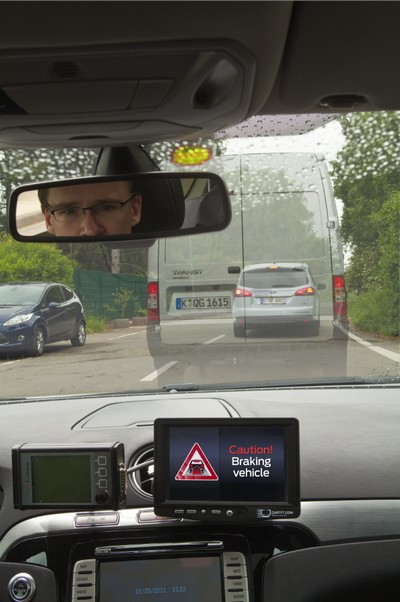Ford has participated in a special test of a high-tech early warning "brake light" that can warn drivers following behind even if they are around a bend or behind other traffic.
The technology is one of 20 potential future systems Ford tested as part of Safe Intelligent Mobility - Testfield Germany (SimTD), a four-year joint industry research project.
In emergency braking situations, the experimental electronic brake light transmits a wireless signal to illuminate a dashboard light in cars following behind. The study found the technology could enable drivers to brake earlier and potentially mitigate or avoid a collision.
The SimTD field tests involved 500 test drivers in 120 vehicles - including 20 Ford S-MAX models. Testers logged more than 41,000 hours and almost a million miles on public roads and an enclosed test track in Germany.
Ford's chief technical officer and vice president, Ford Research and Innovation, Paul Mascarenas, said: "Car-to-car and car-to-infrastructure communications represent one of the next major advancements in vehicle safety. Ford is committed to further real-world testing here and around the world with the goal of implementation in the foreseeable future."
Ford used specially-equipped Ford S-MAX models to help test the potential of car-to-car and car-to-infrastructure communication; also testing obstacle warning system, which alerts to the presence, position and type of potentially hazardous objects in the road, and traffic sign assistant, that keeps in contact with traffic management centres for up-to-date information.
Engineers from Ford's European Research Centre in Aachen, Germany, led the Electronic Brake Light development, testing and data analysis.
Further technologies tested for simTD included:
• Public traffic management, which provides exact traffic prognosis based on comprehensive information; this includes identifying likely traffic scenarios and their impact at the point in the journey when they are encountered rather than at the point of departure.
• In-car internet access, which, for example enables the driver to receive information about free parking spaces or check traffic hotspots by receiving up-to-date pictures from traffic cameras.
Ford tests high-tech brake light that communicates with car behind
- By Fleet News
- |
- 24 June 2013
- News




















Gordon Evans - 24/06/2013 13:35
Great stuff. Have car manufacturers seen what aircraft have in the form of TCAS (Traffic Collision Avoidance System)? If cars are involved in an accident, this could trigger emergency-response vehicles. Also, warning other vehicles approaching an accident is very important. Good work.